Abstract
Background:
Mental health knowledge is an important part of mental health literacy, which is related to one's attitude and coping style when facing mental illness. The awareness rate of mental health knowledge among adolescents is an effective index to evaluate the effect of school mental health education, and the awareness rate of mental health knowledge among Chinese adolescents has not been effectively evaluated.
Methods:
Two electronic databases for English language and 3 electronic databases for Chinese language were searched for relevant studies. Meta-analysis was conducted to analyze the awareness rate among Chinese adolescents. The normal distribution test was conducted using 5 methods. Homogeneity test was conducted, and I2 > 50% indicates existence of heterogeneity and in this case, the random model was adopted; otherwise, we adopt the fixed model. Funnel plot and Egger test was used to confirm whether publication bias existed.
Results:
Seventeen studies were included in this study, comprising 22,164 students from different stages of education (10,437 senior middle-school students, 5589 junior middle-school students, and 6138 college students). The awareness rate of mental health knowledge among Chinese adolescents was only 66%; for university students and middle-school students, their awareness rate was 73% and 61%, respectively. The awareness rate among senior middle-school students was as low as that of junior middle-school students. The awareness rate among college students in developed regions was higher than that in developing regions.
Conclusions:
The awareness rate of mental health knowledge among Chinese adolescents was lower than the goal set in the national mental health work plan. There are gaps in mental health education in different developed areas. The mental health education among adolescent in Chinese mainland needs to be further strengthened.
Keywords: adolescent, awareness rate, mental health knowledge, meta-analysis
1. Introduction
Mental health is an important part of health, and people have realized that there is no health without mental health.[1] A study conducted by the World Health Organization indicated that more than 450 million people worldwide suffer from various mental disorders, of which 121 million suffer from depression, 24 million suffer from schizophrenia, and more than 1 million commit suicide every year.[2]
A study by Phillips et al[3] revealed that the lifetime prevalence rate of various kinds of mental disorders in China is 16.6%, and the prevalence has increased significantly in recent years.
The burden of illness caused by mental disorders has increased rapidly, and the research conducted by Yang et al[4] indicated that mental disorder has become the main cause of years lived with disability in China. Many patients with mental disorders are in poverty due to their illness,[5] and are easily associated with violent attacks against others and society,[6] which has become a major public health and social issues.[7]
Previous studies have proved that only in good mental health can human deal with the adjustment questions at different stages of life.[8] The mental health of adolescent is a hotspot of many psychiatrists because adolescence is a vital transition period of life.[9] The study of current psychiatric pattern in children and adolescents indicated that the incidence of mental health problems among adolescents was higher than other age groups. Taking the study by Araz Altay et al,[10] for example, the researcher investigated the main psychiatric symptoms of adolescents in Turkey, and analyzed the use of psychotropic drugs, providing good guidance for improving the mental health of adolescents in developing countries.[10] Researchers have come to the conclusion that people are more likely to suffer from depression and other mental disorders during adolescence than any other age groups.[11] A nationwide survey shows that the incidence of depression in adolescents is higher than the national average.[12] Previous studies indicated that many adolescents with depression did not choose to seek professional mental health services that may aggravate their illness, and some even commit suicide.[13] When analyzing which factors affect adolescents’ access to professional mental health services, Diamond et al[14] found that lacking of mental health knowledge was a significant risk factor. According to the theory of knowledge–attitude–practice,[15] the change of human behavior is divided into 3 successive stages: knowledge acquisition, belief generation, and behavior formation. That is, human beings first generate beliefs from knowledge, and then the beliefs guide human behavior. Knowledge is the foundation of behavior, belief is the motivation of behavior, and the change of behavior is the ultimate goal. A good indicator to assess the effectiveness of mental health education is the awareness rate of mental health knowledge,[16] and number of studies[17] have proved its significant association with human's mental health status, attitude toward mental illness, and help-seeking behaviour. Burns and Rapee[18] have concluded from their research that adolescents with good mental health knowledge will help themselves in maintaining physical and mental health, reducing the incidence of depression and other mental disorders. Khan et al[19] also found in their study that a good mental health knowledge among depressive university students was significantly associated with less stigma and more medical-seeking behavior. So mental health knowledge is an important index for adolescents, which can not only increase relevant ability, but can also form the right attitude to take the right approach in preventing and dealing with mental disorders. According to the Chinese national mental health work plan (2015–2020), by the end of 2020, the awareness rate of mental health knowledge among adolescents should be up to 80% at least.[20] Thus, it is important to evaluate the awareness rate of mental health knowledge among Chinese adolescents so that we can understand the real gap between the goal and the reality and provide the basis for the future mental health promotion plans. However, we have not found such study.
A meta-analysis of relative literatures was conducted in this study, so that we can provide valuable information for improving quality of mental health education system in China.
2. Methods
2.1. Ethical approval
This study was conducted by extracting relevant data from publicly available literatures. The informed consent of participants is not required for each process carried out in this study. Therefore, this study was not applicable of review approval.
2.2. Search strategy
Two electronic databases for English language (PubMed and Web of Science) and 3 electronic databases for Chinese language were searched for related studies. The query time period was from 2005 to 2019. The search terms in PubMed included (((((awareness rate[Title/Abstract]) AND knowledge of mental health[Title/Abstract]) AND China) OR Chinese)) AND ((((((adolescent[Title/Abstract]) OR middle school students[Title/Abstract]) OR senior high school student[Title/Abstract]) OR Junior high school students[Title/Abstract]) OR college students[Text Word]) OR university students[Title/Abstract]).
2.3. Study selection
Included studies met the following criteria:
-
1.
the study involved adolescents from Chinese mainland, including students from junior high school, senior school, and university;
-
2.
research content was awareness rate of mental health knowledge;
-
3.
the questionnaire used was based on the mental health knowledge content recommended by the National Health Administration[21];
-
4.
only English and Chinese languages were included;
-
5.
the sample size of the included study was greater than 100;
-
6.
included researches were cross-sectional study; and
-
7.
included samples were selected randomly.
2.4. Data extraction
Two authors (YY and SG) independently extracted relevant data from the included studies. Following information were necessary: name of the first author, year of publication, research location, sample size, awareness rate or the number of people who can correctly answer the relevant questions, types of students, and so on.
2.5. Outcome
The primary outcome of this study is the awareness rate among adolescents. According to the types of students, stratified analysis is also carried out.
2.6. Quality assessment of included studies
Two authors independently conducted the evaluation on the following information: representativeness, the consistence of the survey tools, and information integrity. Included studies were classified as “low risk of bias,” “unclear risk of bias,” or “high risk of bias,” with respect to the above information. Scores greater than 3 was considered average quality. The guidelines of the Cochrane reviews are the basis of the above assessment strategy.[22]
2.7. Statistical analysis
The normal distribution test was conducted. According to the test results of 5 methods (the original rate, logarithmic transformation of the original rate, perform logit conversion to the original rate, inverse sine transform of the original rate, and Freeman–Tukey double inverse sine conversion of the original rate), the closest to the normal distribution was selected.[23] The awareness rate among adolescents and corresponding 95% confidence intervals (CIs) were calculated. The heterogeneity was assessed with I2 test, with an I2 > 50% indicating the existence of heterogeneity (if I2 > 50%, random model was adopted; if I2 < 50%, fixed model was adopted).[24] In addition, publication bias of articles involved was evaluated by funnel plot and was confirmed using Egger test.[25] All statistical analyses were conducted using R (version 3.4.4, R Project for Statistical Computing, Vienna, Austria).[26] Statistical tests were considered significant when P < .05.
3. Results
3.1. Study selection
Five electronic databases were searched for relevant studies. At first, we obtained 2024 potentially eligible articles, out of which 458 duplicates were removed. Among the remaining 1566 articles, we excluded 1426 studies after screening their titles and abstracts. Out of the 140 full-text studies, 123 studies without valuable outcomes were ruled out. Finally, a total of 17 articles with 22,164 students were included in the present study, evaluating Chinese adolescents’ awareness rate of mental health knowledge.[27–44] The flow chart is schematically shown in Figure 1.
Figure 1.
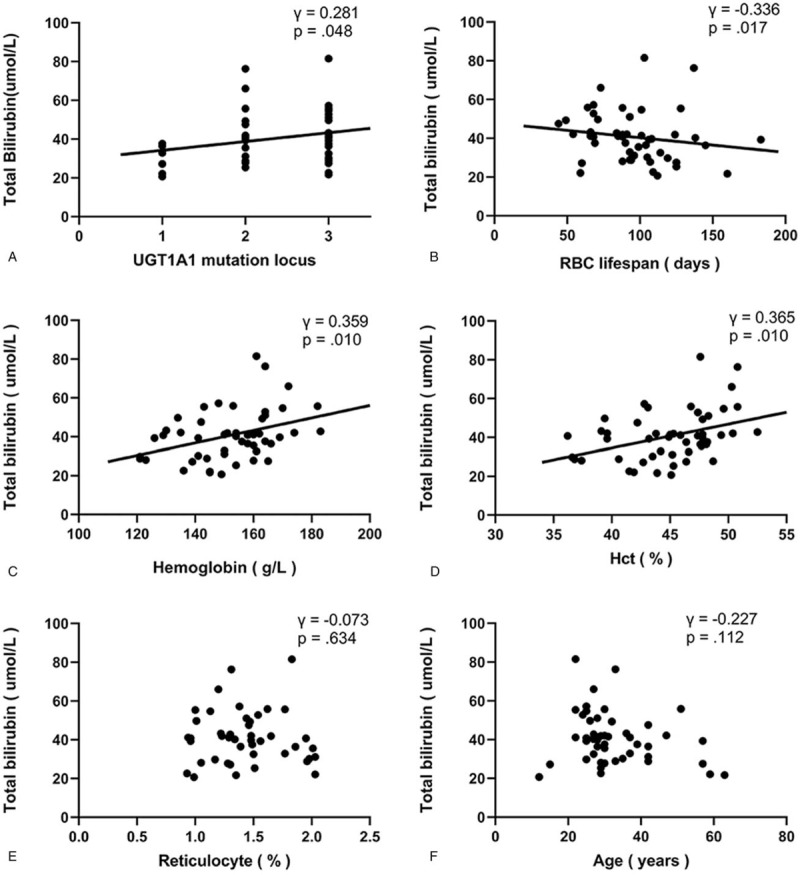
. Flowchart presenting the steps of the literature search and selection.
3.2. Study characteristics
A total of 17 studies were included in this study, comprising 22,164 students from different stages of education (10,437 senior middle-school students, 5589 junior middle-school students, and 6138 college students). There were 8 studies that included the awareness rate among university students, which comprised 6138 college students, and this is about 28% of the total sample. Seven articles included the awareness rate among senior middle-school students and 5 articles included the awareness rate among junior middle-school students. There were 3 literatures that included both senior school students and junior high-school students. The general characteristics of the included studies are shown in Table 1.
Table 1.
The basic information and data of all included studies in the meta-analysis.
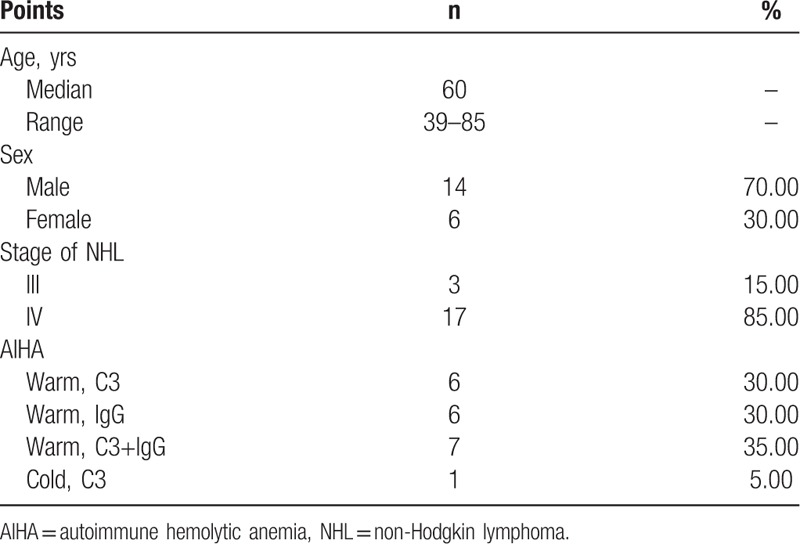
3.3. Quality assessment
The detailed result of the bias assessment is shown in Table 2, from which we can see that although most included studies have good information integrity and sample randomness, the quality of included studies was not up to the expectations.
Table 2.
Risk of bias assessment.
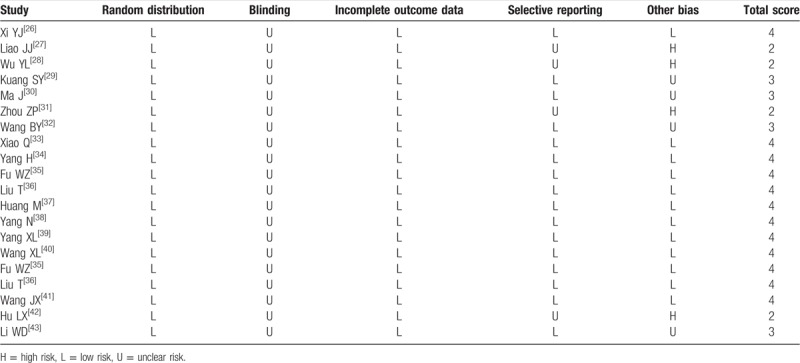
3.4. Overall awareness rate among adolescents in China
Twenty studies from 17 literatures[27–44] were included in the meta-analysis. The result of heterogeneity test indicated that there was a significant heterogeneity (I2 = 96%); therefore, the random model was selected. The combined awareness rate of mental health knowledge among adolescents was 0.66 and the 95% CI was 0.63 to 0.69, which was significantly lower than the relevant standards.[20] The forest plot is shown in Figure 2.
Figure 2.
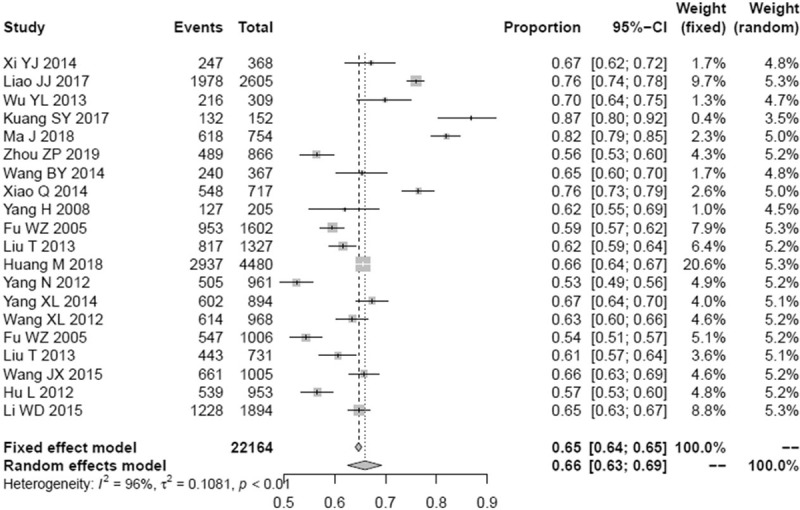
. The forest plot of overall awareness rate among adolescent.
3.5. The awareness rate among university students
In order to obtain the combined awareness rate of mental health knowledge among Chinese university students, a total of 8 studies were included in this study, which comprised 6138 college students. The awareness rate among college students was significantly higher than the overall awareness rate among adolescents (among university students, the awareness rate was 0.73, 95% CI: 0.66–0.79). The detailed result is shown in Figure 3.
Figure 3.
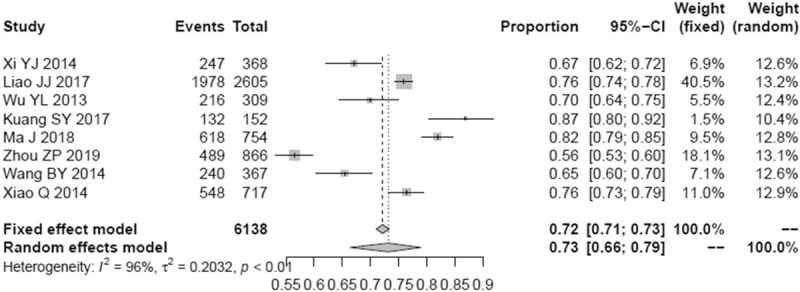
. The forest plot of awareness rate among university students.
We also compared the awareness rate among university students in regions with different levels of development. In this study, Beijing, Shanghai, Guangdong province, Zhejiang province, and Jiangsu province were considered as developed regions, whereas other parts of this country were classified as developing regions. Interestingly, we found that university students in the developed regions have a higher awareness rate of mental health knowledge than students in the developing regions (in developed regions, the awareness rate was 0.75, 95% CI: 0.66–0.82; in developing regions, the awareness rate was 0.70, 95% CI: 0.57–0.81). The stratified analysis of the forest plot is shown in Figure 4.
Figure 4.
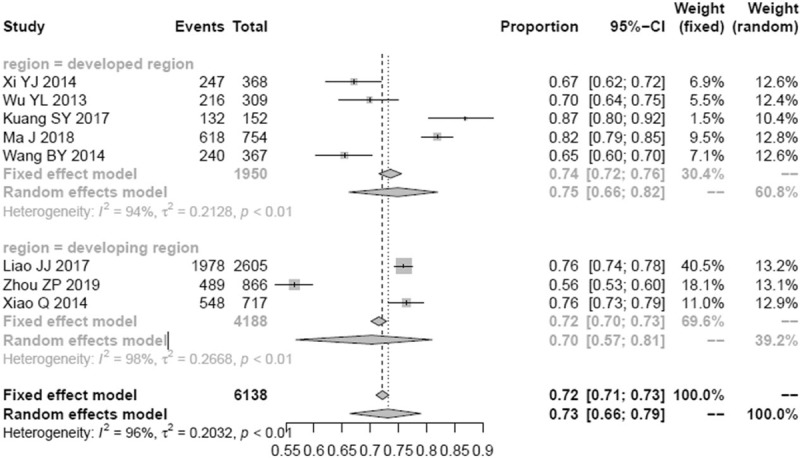
. The forest plot of awareness rate among college students in different development region.
3.6. The awareness rate among middle-school students
Twelve studies from 9 literatures comprising 16,026 students were included to evaluate the awareness rate among middle-school students. The random model was used due to the significant heterogeneity (I2 = 91%), and the result indicated that the combined awareness rate of mental health knowledge among middle-school students was not only lower than the group of college students, but also lower than the overall level of adolescents. The awareness rate of middle-school students was 0.61 and the 95% CI was 0.59 to 0.64. After stratification analysis, we found that the awareness rate among high-school students is almost the same as that of middle-school students (among junior middle-school students, the awareness rate was 0.61, 95% CI 0.56–0.65; among senior middle-school students, awareness rate was 0.62, 95% CI 0.58–0.65). The result of the forest plot is shown in Figure 5.
Figure 5.
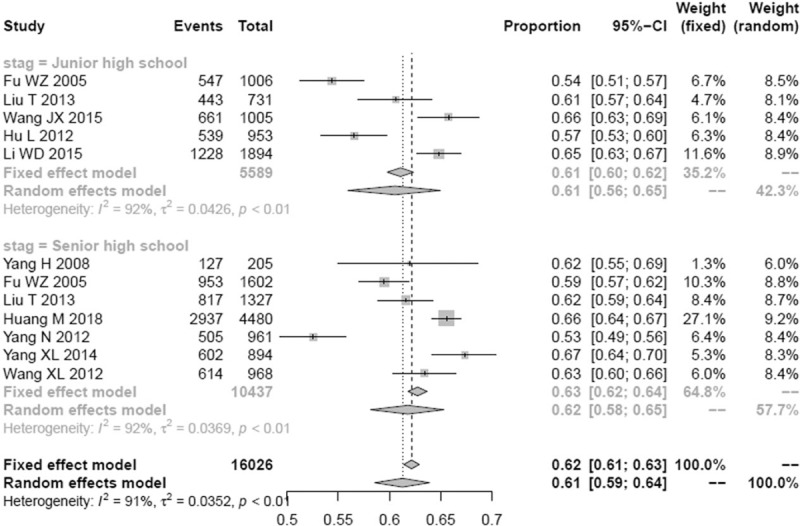
. The forest plot of awareness rate among middle-school students.
3.7. Publication bias
The funnel plot is shown in Figure 6. The result of the Egger test indicated that there was no significant publication bias (t = 0.51, P = .616, bias = 1.56, slope = 0.51). Thus, the validity and credibility of this meta-analysis was confirmed.
Figure 6.

. Funnel plot of publication bias.
4. Discussion
In human life, adolescence is considered to be the most important stage, because in this stage, people have to experience cognitive, biological, and social changes. Research from the World Health Organization showed that many countries were experiencing the increase in suicide rate among adolescents.[45] Although Western countries, such as the United Kingdom, do not also have a high proportion of teenagers seeking professional psychological help, the situation is still better when compared with China.[46] One of the reasons may be that although the communication between China and Western countries has been increasing during last decades, traditional Chinese culture, such as Confucianism, still exerts a profound influence on teenagers. In particular, the Chinese education system (including families and society) considers obedient and quiet children to be good, which makes Chinese children unwilling to seek help when they have mental problems. In addition, China's mental health service system is still being improved, especially the professional mental health services for adolescents, which need to be further improved. Moreover, especially for Chinese middle-school students, their learning tasks are very heavy (in order to enroll a good university), and mental health education has been ignored by both schools and parents in the past. Such reason maybe lead to a higher rate of self-injury and even suicide among Chinese adolescents.[47] Zhang et al[48] suggest that these phenomena may be significantly related to lower mental health literacy. The core content of the mental health literacy is mental health knowledge.[49] Health education is an effective means to improve adolescent mental health knowledge[50]; however, we have not seen any studies on how to evaluate the effectiveness of health education, especially about mental health knowledge among adolescents in China. In addition, clear development goals have been set in Chinese national mental health work plan (2015–2020),[20] the gap between reality and goals needs to be assessed.
In this study, a meta-analysis was conducted to evaluate the awareness rate of mental health knowledge among Chinese adolescents. Overall, the awareness rate of mental health knowledge among Chinese adolescents was only 66%, significantly below the goals set out in the national mental health work plan.[20] Among the adolescents, university students have the highest awareness rate (73%), which is significantly higher than senior middle-school students (62%) and junior middle-school students (61%). If we stratify the analysis by region, we find that the awareness rate among college students in developed regions (75%) is higher than that in developing regions (70%). This indicated health education for college students (on mental health knowledge) needs to be further strengthened, especially in universities in developing regions, which need to make more efforts to improve students’ mental health knowledge.
From the results, we can see that the awareness rate among senior middle-school students and junior middle-school students is almost the same, but both are far below the target set by the national mental health work plan.[20] Logically, senior middle-school students are more mature than junior middle-school students, and they receive more education than junior middle-school students, so their awareness rate should be higher than junior middle-school students. Interestingly, the results, however, did not match such expectations. The above information indicated that the health education for middle-school students (on mental health knowledge) needs to be further strengthened.
In this study, we conducted a meta-analysis to quantitatively analyze the mental health knowledge awareness rate among adolescents in China. Undoubtedly, the present study can provide valuable information for enhancing the mental health education system, especially for adolescents in China; however, some limitations of the present study need attention. First, although a thorough literature search was conducted in this study, we only got qualified documents that were published in Chinese. Second, most of the included studies did not mention the blind method, and the quality of literature needs to be improved. Third, significant variation existed in the number of studies with respect to different groups, for example, 8 articles were about university students, whereas only 5 articles were about junior middle-school students.
In conclusion, the awareness rate of mental health knowledge among Chinese adolescents was only 66%, which is lower than the goal set in the national mental health work plan. The awareness rate of mental health knowledge among Chinese university students was 73%, and the awareness rate among college students in developed regions was higher than that in developing regions. The awareness rate among middle-school students was 61%, and the awareness rate among senior middle-school students was no more than that of junior middle-school students. The abovementioned information indicated that health education for adolescents (on mental health knowledge) needs to be further strengthened.
Acknowledgments
The authors thank all the reviewers for their helpful comments.
Author contributions
SG and FL conceived and designed the analysis. SG, FL, and YY performed the analysis. GS and YY wrote the paper.
Conceptualization: Shengyu Guo, Fuying Li.
Formal analysis: Shengyu Guo.
Funding acquisition: Shengyu Guo, Fuying Li.
Methodology: Yan Yang.
Software: Feiyue Liu.
Writing – original draft: Shengyu Guo, Yan Yang.
Writing – review & editing: Feiyue Liu.
Footnotes
Abbreviation: 95% CI = 95% confidence interval.
How to cite this article: Guo S, Yang Y, Liu F, Li F. The awareness rate of mental health knowledge among Chinese adolescent: a systematic review and meta-analysis. Medicine. 2020;99:7(e19148).
This work was supported by Education Fund of Hunan province (number: 18B409, http://jyt.hunan.gov.cn/sjyt/xxgk/tzgg/201903/t20190318_5297301.html). Hunan Social Science Found project (number: 17YBA014)
The authors report no conflicts of interest.
References
- [1].Prince M, Patel V, Saxena S, et al. No health without mental health. Lancet 2007;370:859–77. [DOI] [PubMed] [Google Scholar]
- [2].Brundtland GH. Mental health: new understanding, new hope. JAMA 2001;286:2391–12391. [DOI] [PubMed] [Google Scholar]
- [3].Phillips MR, Zhang J, Shi Q, et al. Prevalence, treatment, and associated disability of mental disorders in four provinces in China during 2001–05: an epidemiological survey. Lancet 2009;373:2041–53. [DOI] [PubMed] [Google Scholar]
- [4].Yang G, Wang Y, Zeng Y, et al. Rapid health transition in China, 1990–2010: findings from the Global Burden of Disease Study 2010. Lancet 2013;381:1987–2015. [DOI] [PMC free article] [PubMed] [Google Scholar]
- [5].Saxena S, Funk M, Chisholm D. World Health Assembly adopts comprehensive mental health action plan 2013–2020. Lancet 2013;381:1970–1. [DOI] [PubMed] [Google Scholar]
- [6].Hodgins S. Violent behaviour among people with schizophrenia: a framework for investigations of causes, and effective treatment, and prevention. Philos Trans R Soc Lond B Biol Sci 2008;363:2505–18. [DOI] [PMC free article] [PubMed] [Google Scholar]
- [7].Mcbain R, Salhi C, Morris JE, et al. Disease burden and mental health system capacity: WHO Atlas study of 117 low- and middle-income countries. Br J Psychiatry 2012;201:444–50. [DOI] [PubMed] [Google Scholar]
- [8]. Ferraro KF, Wilkinson LR. Age, aging, and mental health. Handbook of the Sociology of Mental Health, 23–24. [Google Scholar]
- [9].Powers SI, Hauser ST, Kilner LA. Adolescent mental health. Am Psychol 1989;44:200–8. [DOI] [PubMed] [Google Scholar]
- [10].Araz Altay M, Bozatli L, Demirci Şipka B, et al. Current pattern of psychiatric comorbidity and psychotropic drug prescription in child and adolescent patients. Medicina (Kaunas) 2019;55:159. [DOI] [PMC free article] [PubMed] [Google Scholar]
- [11].Patel V, Flisher AJ, Nikapota A. Promoting child and adolescent mental health in low and middle income countries. J Child Psychol Psychiatry 2008;49:313–34. [DOI] [PubMed] [Google Scholar]
- [12].Lu J, Wang F, Chai P, et al. Mental health status, and suicidal thoughts and behaviors of migrant children in eastern coastal China in comparison to urban children: a cross-sectional survey. Child Adolesc Psychiatry Ment Health 2018;12:13–4. [DOI] [PMC free article] [PubMed] [Google Scholar] [Retracted]
- [13].Cauce AM, Srebnik D. Before treatment: adolescent mental health help-seeking. Prevent Res 2003;10:6–9. [Google Scholar]
- [14].Diamond GS, O’Malley A, Wintersteen MB, et al. Attitudes, practices, and barriers to adolescent suicide and mental health screening: a survey of Pennsylvania primary care providers. J Prim Care Community Health 2012;3:29–35. [DOI] [PubMed] [Google Scholar]
- [15].Bener A, Ghuloum S. Gender differences in the knowledge, attitude and practice towards mental health illness in a rapidly developing Arab society. Int J Soc Psychiatry 2011;57:480–6. [DOI] [PubMed] [Google Scholar]
- [16].Yan B, Jianfeng LI, Keqing LI, et al. Investigation of the awareness rate for mental health knowledge and attitude about mental illness in urban and rural general population. Mod Prevent Med 2014;11:24–5. [Google Scholar]
- [17].Bamgbade BA, Ford KH, Barner JC. Impact of a mental illness stigma awareness intervention on pharmacy student attitudes and knowledge. Am J Pharm Educ 2016;80:80. [DOI] [PMC free article] [PubMed] [Google Scholar]
- [18].Burns JR, Rapee RM. Adolescent mental health literacy: young people's knowledge of depression and help seeking. J Adolesc 2006;29:225–39. [DOI] [PubMed] [Google Scholar]
- [19].Khan TM, Sulaiman SA, Hassali MA. Mental health literacy towards depression among non-medical students at a Malaysian university. Ment Health Fam Med 2010;7:27–35. [PMC free article] [PubMed] [Google Scholar]
- [20].Xiong W, Phillip MR. Translated and annotated version of the 2015–2020 National Mental Health Work Plan of the People's Republic of China. Shanghai Arch Psychiatry 2016;28:4–17. [DOI] [PMC free article] [PubMed] [Google Scholar]
- [21]. The General Office of the Ministry of Health Issued a Survey and Evaluation Plan for Mental Health Indicators; 2010. Available at: http://www.gov.cn/gzdt/201003/08/content_1550552.htm. [Google Scholar]
- [22].Furlan AD, Pennick V, Bombardier C, et al. Updated method guidelines for systematic reviews in the Cochrane Back Review Group. Spine (Phila Pa 1976) 2009;34:1929–41. [DOI] [PubMed] [Google Scholar]
- [23].Albada SJ, Robinson PA. Transformation of arbitrary distributions to the normal distribution with application to EEG test-retest reliability. J Neurosci Methods 2018;161:205–11. [DOI] [PubMed] [Google Scholar]
- [24].Higgins JPT, Simon G. Quantifying heterogeneity in a meta-analysis. Stat Med 2002;21:1539–58. [DOI] [PubMed] [Google Scholar]
- [25].Saveleva E, Selinski S. Meta-analyses with binary outcomes: how many studies need to be omitted to detect a publication bias? J Toxicol Environ Health A 2008;71:845–50. [DOI] [PubMed] [Google Scholar]
- [26]. Cre GS, Aut. Meta: meta-analysis with R.2014. [Google Scholar]
- [27].Yingjun X, Bin Z, Wei L, et al. Knowledge about mental health in the college students from one university in Beijing. Chin J Health Psychol 2014;22:980–3. [Google Scholar]
- [28].Liao JJ, Zheng YN, Tang H. Awareness rate of mental health knowledge among undergraduates in Guangzhou. Foreign Med Sci (Section of Medgeography) 2017;38:332–5. [Google Scholar]
- [29].Wu YL, Wang Y, Feng H, et al. Investigation and analysis on the knowledge rate of mental health among medical students in higher vocational colleges. J Health Vocat Educ 2013;31:108–10. [Google Scholar]
- [30].Kuang SY, Huang YX, Song SK, et al. Mental health knowledge and attitude toward mental illness among postgraduate students in a medical university of Guangzhou City. Occup Health 2017;33:2848–51. [Google Scholar]
- [31].Jiao MA, Qi LI, Mi S, et al. Mental health awareness of undergraduates in military medical university and its influencing factors research and analysis. Nurs Pract Res 2018;15:132–5. [Google Scholar]
- [32].Zhou ZP, Ruan XL, Lan YG, et al. A survey on mental health status of college students in Longyan city. Strait J Prevent Med 2009;15:32–3. [Google Scholar]
- [33].Wang BY, Zhu XZ. The awareness rate of mental health knowledge among college students in Ningbo. J Liaoning Med Univ 2014;12:70–2. [Google Scholar]
- [34].Qiang X, Xiaohong L, Zhen W. Awarenesss of mental health knowledge of undergraduates in Wuhan. Chin J Health Psychol 2014;22:348–50. [Google Scholar]
- [35].Hong Y, Li SU, Tong H. Survey of awareness rate of mental health of 205 senior one students in high school. Mod Prevent Med 2008;35:2078–9. [Google Scholar]
- [36].Fu WZ. Investigation on the awareness rate of mental health knowledge among 4007 college students. Shanghai Arch Psychiatry 2005;17:12–3. [Google Scholar]
- [37].Ting L, Man-Hua Z, Yuan L, et al. Investigation of awareness rate on mental health knowledge among middle school students in rural areas of Shunyi District, Beijing. Chin J Health Educ 2013;29:877–81. [Google Scholar]
- [38].Huang M, Zhan HL, He ZW, et al. A survey on the awareness of mental health knowledge among middle and high school students in Xindu District of Chengdu. Nurs Integr Tradit Chin West Med 2018;4:86–8. [Google Scholar]
- [39].Yang N, Chen LM, Li WY, et al. Investigation on psychological health care knowledge of middle school students in Guangzhou. Chin J Sch Health 2012;33:220–1. [Google Scholar]
- [40].Yang XL, Huo XN, Lv HB, et al. Survey of awareness rates of mental health knowledge for college and high school students. Med J Chin People's Health 2014;26:76–8. [Google Scholar]
- [41].Xiaoling W, Pingfei L, Yuan P. An investigation on mental health awareness of middle school students in Changsha. Chin J Health Psychol 2012;20:248–50. [Google Scholar]
- [42].Wang JX, Lan LM, Zhang DY, et al. Investigation on the knowledge rate of mental health among middle school students. Zhejiang Prev Med 2015;27:1281–3. [Google Scholar]
- [43].2012;Hu LX, Xu J. Investigation on psychological health knowledge and behavior of some middle school students in a district of Xiamen city. 26:160–1. [Google Scholar]
- [44].Weidong L, Yonghe S, Wenxia S. Investigation and analysis of the awareness rate for mental health knowledge of junior middle school students in Taian. J Psychiatry 2015;28:254–7. [Google Scholar]
- [45].Diekstra RFW. Suicidal behavior and depressive disorders in adolescents and young adults. Neuropsychobiology 1989;22:194–207. [DOI] [PubMed] [Google Scholar]
- [46].Kaess M, Brunner R, Parzer P, et al. Risk-behaviour screening for identifying adolescents with mental health problems in Europe. Eur Child Adolesc Psychiatry 2014;23:611–20. [DOI] [PubMed] [Google Scholar]
- [47].Tang J, Yu Y, Wu Y, et al. Association between non-suicidal self-injuries and suicide attempts in Chinese adolescents and college students: a cross-section study. PLoS One 2011;6:e17977. [DOI] [PMC free article] [PubMed] [Google Scholar]
- [48].Zhang SC, Tao FB, Wu XY, et al. Low health literacy and psychological symptoms potentially increase the risks of non-suicidal self-injury in Chinese middle school students. BMC Psychiatry 2016;16:327. [DOI] [PMC free article] [PubMed] [Google Scholar]
- [49].Jorm AF. Mental health literacy: public knowledge and beliefs about mental disorders. Br J Psychiatry 2000;177:396–401. [DOI] [PubMed] [Google Scholar]
- [50].Maier AT, Brown RC, Fegert JM. Knowledge transfer: a worldwide challenge in child mental health: a recommendation to the readership of CAPMH concerning the revised version of the IACAPAP Textbook of Child and Adolescent Mental Health. Child Adolesc Psychiatry Ment Health 2018;12:14. [DOI] [PMC free article] [PubMed] [Google Scholar]


